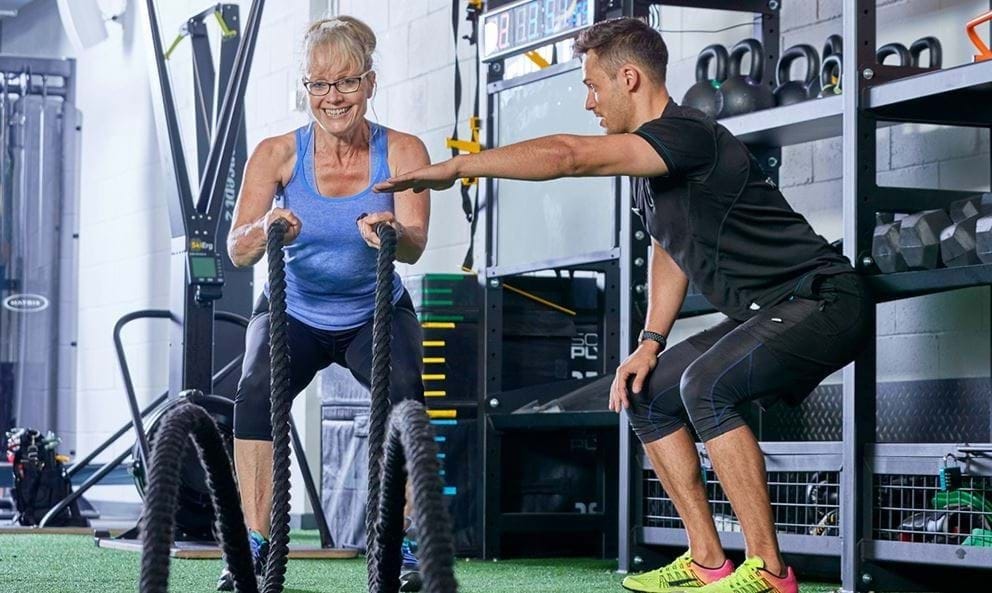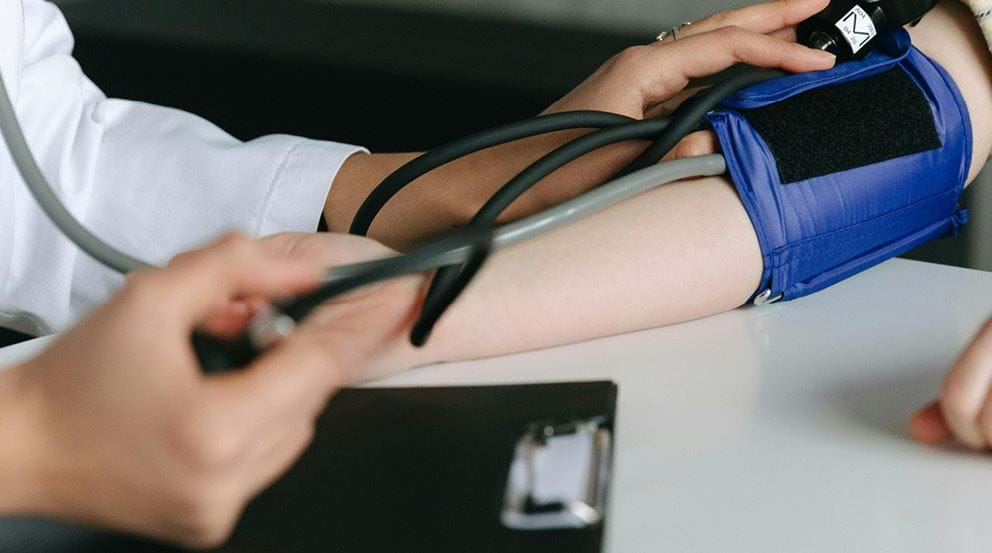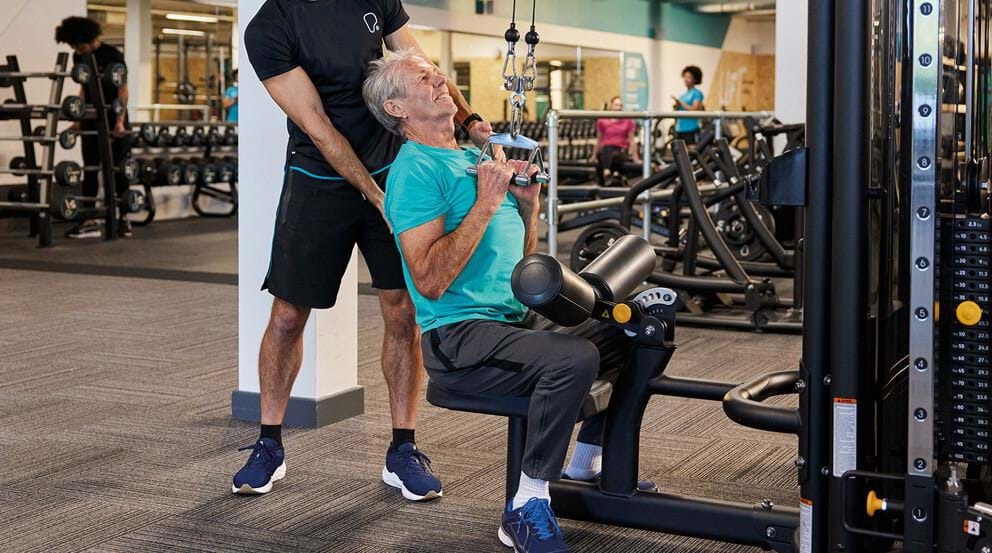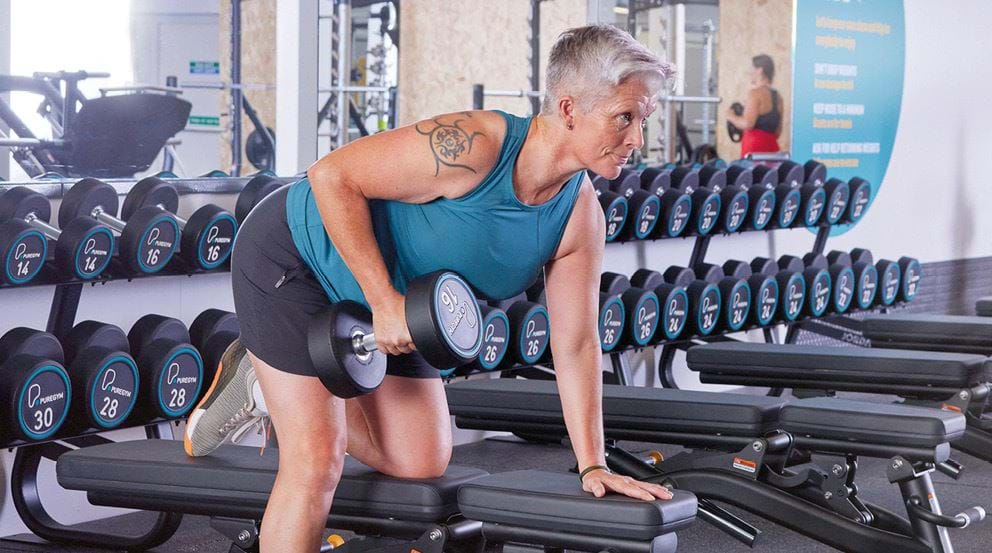Best Exercises for Over 50s

Keeping fit and active no matter what age you are is important for our health. As we get older, our fitness levels naturally decline so it becomes even more important to keep exercise an integral part of our everyday life.
Here's a quick guide and exercise program for over 50s to help you get started with fitness and ultimately improve your health from Personal Trainer and Coach Dan Quirion.
If you've never stepped foot in a gym before, we understand that this can also be quite intimidating. Well firstly, don't worry, everyone's welcome at a PureGym -- Val was 59 when she began her journey to being a powerlifting record holder
Here's how you can get started:
Exercise program for over 50s
Step 1: Warm up
The easiest way to warm up is by picking one of the many options available in the gym to increase your heart rate and promote blood flow.
These include, but aren't limited to:
- The treadmill
- The cross-trainer
- The rower
Pick any of the above and spend 3-5 minutes at about 60-70% of your maximum effort, if you feel comfortable doing so. If you have high blood pressure, it's worth consulting your doctor before you take up a new training regime.
After that, you can perform a few mobility exercises to help mobilise a few joints, like the ones outlined below. Often, as we get older (particularly those over 50) our joints can become a little tighter, so it's important to loosen them before working out.
- The world's greatest stretch -- this has earned its name by targeting every muscle in the body. From a plank position with hands shoulder width apart on the ground and your feet straight out behind you, bring your right foot up so it's next to your right hand (on the outside); this is starting position for this stretch. Keeping your upper arm in contact with your leg, bend the elbow of your right arm until (ideally) your forearm is flat on the floor. Hold for a moment, before bring the same arm upwards and twist your upper body until your arm points straight up to the ceiling. Hold for a moment, return to starting position and then, finally, drop your left knee to the ground, sit on your left heel and lean back to stretch out right leg straight. Return to start position and repeat several times before switching legs and doing the same on the other side.
- Shin boxes -- great for opening up your hips. Sit on the floor with your legs bent at the knees and your feet flat on the floor in front of you. Open your legs into a straddle position. Keeping the left edge of your feet planted on the floor, turn your torso to face left and twist your hips and legs until both knees touch the floor. Return to the starting position and repeat on the right hand side.
- Thoracic wall slides -- an excellent way to stretch out your back and spine. Lean your whole back pressed against a wall, with your feet a few inches off the wall and your knees slightly bent. Bend your arms and flatten them back, so the backs of your hands are against the wall. Then slowly slide them, upwards above your head, keeping them against the wall as they move. Once they're as high as you can go without overexerting yourself, slowly lower them back down. Repeat.
Perform anywhere from 5-10 times each after you've used a treadmill and then activated major muscle groups.
It's worth noting that evidence shows that static stretching doesn't improve performance and therefore you static stretching would be better performed at the end of your workout, never in the beginning.
Step 2: Training
After you complete your warm up, you may be thinking 'What should I do when I go to the gym? Do I need to use machines?'
The simplest way to start is by either using your own bodyweight, which can be done at home or in the gym, or by using the resistance machines.
If you don't have experience using free weights and barbells, it's best that you slowly work your way up to this point once you've mastered the movements and feel comfortable doing so. This is particularly true as we get older, as injuries can are more likely to have a longer-lasting impact.
I would recommend to include the following in your exercise routine:
- two to three workouts a week
- full body sessions during these days
- keeping a track of the weights that you're using
- workouts you enjoy
- exercises that target your legs, chest, back, and shoulders for the most part
Example exercises for over 50s would include a workout like the below:
1. Bench Press - 4 sets of 6-15+ reps (horizontal push)
A barbell lift that, ideally, would use the bench press at your gym (ask a Personal Trainer at your gym if you're not sure what it looks like or can't find it). A bar weighs 20kg as standard, so try this with just the bar before including additional weights. When you do add them in add small incremental weights of around 1.25kg at a time until you find the right challenge.
Lie on the bench, position yourself with your upper back and hips flat, your feet firmly on the floor, and a slight arch in your lower back. Think about pulling your shoulder blades back and down, pushing into the bench. Flex your upper back and abdominal muscles, and squeeze your shoulder blades together as you gently breathe in, unhook the barbell and slowly lower it towards your sternum, being sure to not bounce the bar out of the bottom of the movement. Once your hands are in line with your elbows, pause for a moment, before driving the bar upwards to a starting position. Repeat.
2. Row - 4 sets of 6-15+ reps (horizontal pull)
There are a few different versions you can do of these -- this example is the bent-over barbell rows. Load a barbell up with the right weight for you (again, starting with the bar and adding small weights until you're comfortable to start but challenged for the last few reps of each set), take it with both hands, around shoulder-width apart and with an overhand grip. Plant your feet at shoulder width and bend at the waist, keeping your back straight and your head up, until the barbell sits just below your knees. This is your starting position. Pull the bar straight up to your lower chest while focusing on your upper and lower back, pause for a moment and gently ease back to starting position. Repeat.
3. Shoulder press - 4 sets of 6-15+ reps (vertical push)
Take a seat at the shoulder press machine -- it looks like a seat with handles either side, but if you're not sure what to look for, ask a PT on the gym floor who can help you - and ensure the handles are adjusted so they sit at roughly your shoulder height. Set the machine to an appropriate weight; start low and build up from there. Take hold of the handles and push them directly overhead until your arms are straight but your elbows aren't locked. Slowly ease your arms back to starting position. Repeat.
See our shoulder press guide for more details.
4. Lat pull-down - 4 sets of 6-15+ reps (vertical pull)
Facing the lat pull down machine (again, ask a PT if you're not sure which one it is!), grab the pull down bar with your palms facing forward at a grip outside of shoulder-width. Sit with the knee pads at a comfortable height and set the weight to a comfortable level for you.
Engage your lat muscle by dropping your shoulders down, then squeeze your shoulder blades to pull the bar towards the top of your chest whilst leaning slight back.
Slowly return the bar to starting position. Don't let the weight crash into the plates and don't let it pull you off the seat.
See this lat pull-down video for guidance.
See this lat pull-down video for guidance.
5. Leg Press - 4 sets of 6-15+ reps
Sit at the leg press machine with your feet hip-width apart on the foot plate and your knees bent at a 90 degree angle. Set the weight to something appropriate for you (adding weight on this machine will involve adding actual plates as there's no weights built into the machine). Push out and straighten your legs, leaving a slight bend at the knees. Slowly return to the start position being careful not to allow the weights in the stack to touch -- this will help to maintain the resistance on your muscles. Repeat. See our leg press guide for more information.
6. Lunges - 4 sets of 6-15+ reps
Find out more about these with this How to do Lunges guide.
Try to limit your rest time for all of the above to 60-90 seconds if possible. The shorter the rest periods the harder the workout will be but make sure to go at a pace that's comfortable for you.
How often to work out
You can repeat this workout two to three times a week, making sure you give yourself one or two days off in between to allow your body to recover.
Adjusting your training
You may find that the weights you use gets easier as you get stronger. You can adapt your training to suit your improved strength by either try to add more weight (I would recommend adding 1-2kg where possible) or try to add more reps. For example, if you start by bench pressing 20 kilos week and then 22 on week two. Or bench 20 kilos for 6 reps in week one and then for 7 reps in week two. Although this might seem simple, over time these marginal gains add up. Ensure to keep good form as you increase your weight or reps.
Include plenty of recovery time
I would also suggest you give your body a slight rest after 3-5 weeks of training. We call this a 'deload week'. All you'll do is reduce the amount of work you do compared to previous weeks. For example, you might reduce your programmes volume in half. This will allow your body to recover, adapt, and come back stronger than before for your next 3-5 weeks of training.
Step 3: Core and Cardio
Core workouts
I personally recommend you do your core at the end of your training before your cardio. Start with bodyweight core exercises, like planks, side planks, dead bugs, or variations of these. Two sets of 8-15 repetitions is more than enough at the end of each workout.
How and when to complete your cardio
Cardio can be done either at the end or at the beginning of your workout. I personally prefer to do it at the end because I want to be as fresh as possible when it comes to lifting weights. Try both and you can tweak things from there. Aim for 15-20 minutes on any cardio machine working at about 70%+ of your max. Do this a minimum of twice per week adding 1-2 minutes a week where possible, similarly to what we did with our training programme above.
As you get more fit, you can then start increasing the pace overtime. If you do spin classes, you can also try to increase the resistance and the overall effort you put forth week by week.
Step 4: Don't forget to cool down
This is the time when you can static stretch where you feel like you need it. I would recommend you try deep breathing exercises - 7 seconds in through the nose, 11 seconds out through the mouth. Doing so while you lay down, in a quiet place, will help your body turn on its recovery mode.
Summary
Keep it simple:
- Warm-up -- raise core temperature, heart rate, get lunges primed, and blood flowing
- Activate & Mobilise -- bodyweight movements to help you prime your body and joints further before exercise
- Strengthen the whole body - include both push and pull exercises and horizontal and vertical movements while doing 1-2 leg exercises using machines to help you master movements
- Include core exercises -- body weight movements are more than enough
- Cardio -- can be done before or after, up to you
- Cool down -- to minimise any aches and pains after your workout.
Don't let gym-timidation stop you getting fit in your 50s. Try the plan above and enjoy a strong and healthy body. Still not sure where to start? Speak to a Personal Trainer and they'll be able to guide and support you in your fitness journey.
Before starting a new exercise programme, please consult your Doctor or a qualified fitness professional.


